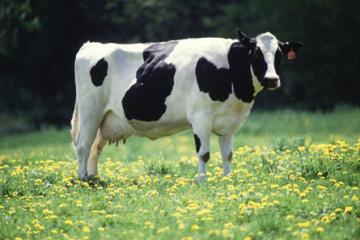Genome to Phenome: ARS Research in Precision Agriculture

Agricultural Research Service scientists, along with international partners in the Agricultural Genome to Phenome Initiative, have been working to build a better dairy cow. (Keith Weller, K5176-3)
How do you build a better dairy cow? Use a tool designed to study the human genome, of course.
Working alongside international research partners in the Agricultural Genome to Phenome Initiative (AG2PI), Agricultural Research Service (ARS) scientists are using technology to meet the challenges of the increasing global population and ever-changing environmental stressors. The goal of AG2PI is to better understand how genetics and the environment together influence the performance of plants and animals. This is easier said than done because regional environmental differences can vary the results of seeds from the same plant.
“We know that nature (genotype) and nurture (environment and management) are both important factors in agricultural production (phenotype),” said Caird Rexroad III, ARS national program leader for animal production and protection in Beltsville, MD. “We need to better understand exactly how they affect production to develop optimal production strategies that are tailored to the diversity of genetics and environments that make up U.S. and world agriculture.”
To achieve this goal, AG2PI reaches across kingdoms (scientific classifications) to examine genome-to-phenome challenges. Scientists in the various specialties work together to identify and fill in similar research gaps, access advanced cyberinfrastructure, and share data and new technology, such as sensors, robotics, and imaging platforms.
“AG2PI is a community of scientists who share a passion for agricultural research and developing technologies that improve our ability to produce a safe, abundant, healthy, and affordable food supply,” Rexroad said. “This platform is inclusive of many scientific disciplines that may not have interacted in the past, such as breeders, engineers, economists, social scientists, etc., and works by sharing ideas, providing trainings on state-of-the-art technologies, and enhancing communication and collaboration.”
One example of how ARS scientists used AG2PI to avoid research “stovepipes” (the term used to describe how one group may isolate its information from other unrelated groups) involves the international research to improve dairy cattle.
“The Genome-to-Phenome Initiative began for us in 2007,” said Curt Van Tassell, research geneticist at the ARS Animal Genomics and Improvements Laboratory in Beltsville. According to Van Tassell, the landmark study used existing technology from one scientific discipline and applied it to another; in this case, technology was developed for the human genome and adapted for use in the cow by designing a DNA chip to characterize the whole genome of the cow.
“We worked closely with dairy genetics industry partners to implement genome-enabled genetic improvement with dramatic impact in the dairy industry,” Van Tassell said. “With the help of our partners, we revolutionized the world of genetic improvement in livestock in one fell swoop.”
While AG2PI is not in itself a scientific project, it supports all agricultural research that will benefit farmers, ranchers, and consumers, Rexroad said. “Farmers and ranchers will have access to genetics and management practices that will increase yields, improve crop and animal health and well-being, increase production efficiency or product value, and improve sustainability in the production system,” he said.
“AG2PI is all about agricultural research, and it is inclusive of many scientific disciplines, and that ties into the ARS goal of finding solutions to agricultural problems that affect Americans every day from farm to table,” Rexroad said. – By Scott Elliott, ARS Office of Communications.

